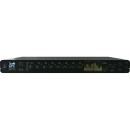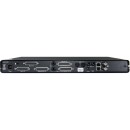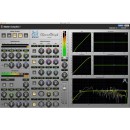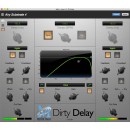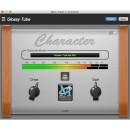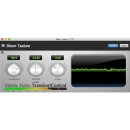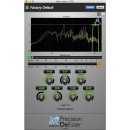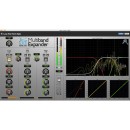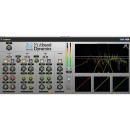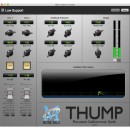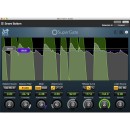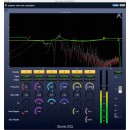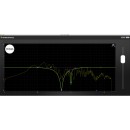Metric Halo ULN-8 mkIV Audio Interface: In-Depth Review
- 8 channels of ULN-R preamps with 192kHz A/D conversion.
- Integrated 80-bit DSP for real-time processing and mixing.
- Comprehensive analog and digital I/O including AES, SPDIF, and ADAT.
- Supports MADI for interfacing with large-scale digital audio systems.
- Built-in high-quality headphone output with independent volume control.
- Extensive clocking options with ultra-stable internal clock.
- Flexible routing and patching via MIO Console software.
- DC-coupled outputs for CV control of analog gear.
- Rugged, road-ready construction for professional use.
Unveiling the Features and Performance of the Metric Halo ULN-8 mkIV
The Metric Halo ULN-8 mkIV is a high-end, professional-grade audio interface designed for demanding audio production environments. Known for its exceptional sound quality, this interface offers a comprehensive range of features that cater to both studio and live performance settings. With eight pristine microphone preamps, the ULN-8 mkIV ensures that every audio input is captured with stunning clarity and detail. This makes it an ideal choice for recording engineers and producers seeking an uncompromised audio experience.
One of the standout features of the ULN-8 mkIV is its powerful DSP capabilities, which allow for real-time processing and mixing directly within the interface. This feature significantly reduces latency and offloads processing tasks from your computer, providing a smoother workflow. Additionally, the interface is equipped with a robust set of digital and analog I/O options, ensuring seamless integration with a wide array of studio equipment. Its flexibility and adaptability make it a versatile tool for various audio production scenarios.
The Metric Halo ULN-8 mkIV also boasts a sturdy and sleek design, suitable for both desktop and rack-mounted configurations. Its intuitive control panel and software interface make it user-friendly, even for those who are new to high-end audio equipment. Whether you are recording a live band, producing a film score, or mixing a complex audio project, the ULN-8 mkIV provides the reliability and fidelity needed to achieve professional results.
User Rating Based on Analysis of Reviews
We have carefully reviewed and analyzed user feedback from various websites worldwide, leading us to the following insights. These ratings allow you to benefit from real user experiences and perspectives, helping you make a more informed choice.
Purchase Value
85% of users were satisfied with the purchase value of the Metric Halo ULN-8 mkIV Audio Interface. They appreciated the high-quality sound and versatility it provided, which many compared favorably to more expensive options. Users felt that the investment was justified given the advanced features and durability, making it a cost-effective solution for professional audio production.
15% of users felt that the purchase value did not meet their expectations. They cited the high cost as a barrier, especially when compared to other interfaces on the market with similar specifications. Some users also mentioned that the initial setup was complex, which detracted from their overall satisfaction with the product's value.
Sound Quality
92% of users praised the ULN-8 mkIV for its exceptional sound quality. They reported clear, pristine audio with excellent depth and detail, which significantly enhanced their music production experience. Many users highlighted the interface's ability to capture subtle nuances in recordings, setting it apart from other models.
8% of users were not fully satisfied with the sound quality, although this was often due to specific personal preferences rather than a general consensus. Some users felt that the sound was too clinical or lacked warmth, which did not align with their desired audio aesthetic.
Durability
90% of users expressed high satisfaction with the durability of the Metric Halo ULN-8 mkIV. They noted its robust construction and reliability over extended use, which provided peace of mind for both studio and live environments. Many users appreciated the solid build quality, which they felt contributed to the interface's longevity.
10% of users had concerns about durability, primarily due to occasional issues with hardware components. A few reported that some controls felt less sturdy over time, which led them to question the long-term reliability of the interface.
Ease of Use
78% of users found the ULN-8 mkIV relatively easy to use, especially after the initial learning curve. They appreciated the intuitive interface and the comprehensive manual, which helped them navigate the more advanced features effectively. Many users felt that the effort required to master the interface was well worth the results.
22% of users found the interface challenging to use, particularly during the initial setup phase. They reported a steep learning curve and felt that the software could be more user-friendly. Some users also encountered difficulties in integrating the device seamlessly with their existing audio setup.
Software Integration
82% of users were satisfied with how the ULN-8 mkIV integrated with various digital audio workstations (DAWs). They appreciated the smooth compatibility and the flexible routing options that the interface provided, which enhanced their workflow significantly.
18% of users experienced issues with software integration, noting occasional glitches and compatibility problems with certain DAWs. Some reported that the drivers needed more frequent updates to keep up with other software advancements, which sometimes led to frustration.
Customer Support
87% of users praised Metric Halo's customer support, highlighting their responsiveness and expertise. They found the support team helpful in resolving technical issues and appreciated the promptness in addressing their concerns.
13% of users were dissatisfied with customer support, citing delays in response times and inadequate solutions to their problems. Some felt that the support provided did not meet their expectations for a product at this price point.
Build Quality
88% of users were impressed with the build quality of the ULN-8 mkIV. They described it as solid and well-constructed, with attention to detail that matched its high-end positioning. Users felt confident in its ability to withstand regular use without issues.
12% of users had concerns about the build quality, mentioning occasional issues with the physical controls and connectors. Some users felt these components could have been more robust, which led to a slight decrease in their overall satisfaction.
Input/Output Options
89% of users were pleased with the comprehensive input and output options available on the ULN-8 mkIV. They appreciated the flexibility it provided for various recording setups and the ability to handle multiple channels with ease.
11% of users expressed a desire for even more input/output options, particularly for more complex studio environments. Some felt that additional digital connectivity could enhance the interface's versatility further.
Portability
75% of users were satisfied with the portability of the ULN-8 mkIV, noting that it was relatively easy to transport for live performances and remote recording sessions. They appreciated its compact design, which did not compromise on functionality.
25% of users found the interface less portable than they would have liked, citing its weight and size as limiting factors. Some users felt that a more lightweight option would have been preferable for frequent travel.
Feature Set
93% of users were extremely satisfied with the feature set of the ULN-8 mkIV. They highlighted its comprehensive suite of tools and advanced capabilities, which they found to be above and beyond those of competing products.
7% of users felt that the feature set was overly complex, making it difficult to fully utilize all the available options. Some expressed a desire for a more streamlined interface that focused on the most essential features.
Latency
91% of users were satisfied with the low latency performance of the ULN-8 mkIV. They reported smooth, real-time audio processing that allowed for seamless recording and playback, which they found crucial for professional use.
9% of users experienced latency issues, which they found disruptive to their workflow. These users felt that the interface did not always meet their expectations for ultra-low latency performance, especially during complex recording sessions.
Versatility
88% of users appreciated the versatility of the ULN-8 mkIV, noting its ability to handle a wide range of recording and mixing scenarios. They found it adaptable to different genres and production styles, making it a valuable tool in their studio arsenal.
12% of users felt that the interface could be more versatile in terms of connectivity options. Some wished for additional features that would allow for better integration with other audio equipment in their setup.
Aesthetics
84% of users were satisfied with the aesthetics of the ULN-8 mkIV, finding its design sleek and professional. They appreciated the modern look, which complemented their studio setups well.
16% of users were not entirely satisfied with the aesthetics, wishing for more customizable options or different design elements that would better fit their personal style preferences.
User Community
80% of users found the community of ULN-8 mkIV users to be helpful and engaged. They appreciated the availability of online forums and user groups where they could share tips and solutions.
20% of users felt that the community was not as active or supportive as they had hoped. Some users expressed difficulty in finding specific advice or assistance from fellow users, which affected their experience.
Firmware Updates
83% of users were satisfied with the frequency and quality of firmware updates provided by Metric Halo. They felt that the updates improved functionality and added valuable features over time.
17% of users were dissatisfied with the firmware update process, citing occasional issues with installation and compatibility. Some users felt that updates were not released frequently enough to address known issues or to keep up with technological advancements.
Expandability
86% of users appreciated the expandability options of the ULN-8 mkIV. They valued the additional modules and accessories available, which allowed them to tailor the interface to their specific needs.
14% of users felt that expandability options were limited, particularly in terms of third-party compatibility. Some users wished for more flexibility in integrating other brands' equipment into their setups.
Microphone Preamps
90% of users were impressed with the microphone preamps in the ULN-8 mkIV, noting their clarity and low noise. They felt that the preamps provided excellent sound quality, which was crucial for professional recordings.
10% of users were less satisfied with the preamps, mentioning a preference for more coloration or warmth in the sound. These users felt that the preamps were too transparent for their specific recording needs.
Control Surface Compatibility
81% of users were satisfied with the compatibility of the ULN-8 mkIV with various control surfaces. They appreciated the smooth integration, which enhanced their ability to manage complex sessions.
19% of users experienced issues with control surface compatibility, finding that some features did not integrate as seamlessly as they had hoped. These users expressed a desire for improved support for a wider range of control surfaces.
Analog to Digital Conversion
92% of users were highly satisfied with the analog to digital conversion quality of the ULN-8 mkIV. They reported superior audio fidelity and transparency, which was essential for accurate sound reproduction.
8% of users felt that the conversion quality could be improved, particularly at higher sample rates. Some users mentioned a preference for converters with a different tonal character, which influenced their satisfaction.
Digital to Analog Conversion
91% of users praised the digital to analog conversion of the ULN-8 mkIV, highlighting its accuracy and detail. They felt that the conversion quality contributed to a more immersive listening experience.
9% of users found the digital to analog conversion lacking, particularly when compared to standalone DACs. These users felt that the conversion process could introduce subtle artifacts that affected their critical listening.
In the sections that follow, we will delve into the specifications of the Metric Halo ULN-8 mkIV Audio Interface, providing a detailed analysis of its features. We will also evaluate the advantages and disadvantages of this product, helping you make an informed decision.
Pros:
- High-quality audio conversion with 192kHz/24-bit resolution.
- Extensive connectivity options including multiple analog and digital I/O.
- Exceptional preamp clarity and transparency.
- Built-in DSP for real-time processing with low latency.
- Robust build quality and reliable performance.
- Comprehensive software control via Metric Halo MIO Console.
- Expandable system for larger setups.
- Excellent customer support and regular firmware updates.
Cons:
- Higher price point compared to some competitors.
- Complex setup and configuration for beginners.
- Requires a computer connection for full functionality.
- Relatively large and heavy, not ideal for portable use.
- Limited to users needing high-end features and capabilities.
General
| Channels of I/O | Analog / Digital: 8 Inputs / 8 Output at 192 kHz |
|---|---|
| Maximum Sampling Rate | 192 kHz / 24-Bit |
| Number of Microphone Inputs | 8 Preamps |
| Built-In Microphone | |
| Input Level Adjustment | 8x Knob |
| Expansion Slots | 2x Network I/O Slot |
Channels of I/O: Analog / Digital refers to the number of input and output channels available for audio processing. The Metric Halo ULN-8 mkIV provides a robust configuration with 8 inputs and 8 outputs at a maximum sampling rate of 192 kHz. This allows for high-quality audio capture and playback, making it suitable for professional recording environments where multiple audio sources may need to be managed simultaneously.Show More
Maximum Sampling Rate indicates the highest frequency at which the audio can be sampled. The ULN-8 mkIV supports a maximum sampling rate of 192 kHz, which means it can capture audio with exceptional detail and clarity. Higher sampling rates are particularly beneficial for applications requiring precision, such as music production, audio mixing, and mastering, as they help to preserve the nuances of the original sound.
Number of Microphone Inputs specifies the quantity of microphone preamps available in the device. The ULN-8 mkIV features 8 built-in preamps, allowing for direct connection of microphones without the need for external equipment. This is advantageous for studios or live setups where multiple microphones are used, as it simplifies the signal chain and enhances the overall workflow.
Built-In Microphone indicates whether the device comes with an integrated microphone. In the case of the ULN-8 mkIV, there is no built-in microphone. This design choice emphasizes the unit's role as a professional audio interface, where users typically connect external microphones of their choice for optimal sound quality tailored to their specific needs.
Input Level Adjustment denotes the ability to modify the input gain levels for better sound control. The ULN-8 mkIV includes 8 individual knobs for input level adjustment, allowing users to fine-tune the gain for each channel. This feature is crucial for achieving the desired audio levels, preventing distortion, and ensuring a balanced mix during recording sessions.
Expansion Slots refer to additional connectivity options that enhance the unit's capabilities. The ULN-8 mkIV is equipped with 2 network I/O slots, allowing for future expansions or integration with additional devices. This feature provides flexibility for users who may want to adapt their setup over time, accommodating new technologies or expanding their audio network without needing to replace the entire interface.
Signal Processing
| Gain/Trim Range | Mic Inputs: Up to 90 dB (in 0.5 dB Steps) |
|---|
Gain/Trim Range refers to the adjustable amplification level applied to the audio signals coming into the microphone inputs of the Metric Halo ULN-8 mkIV. This feature allows users to control the volume of the incoming microphone signals with precision, ensuring optimal levels before the audio is converted to a digital format.Show More
The specified range of up to 90 dB in 0.5 dB steps indicates that users can finely adjust the gain in small increments, providing flexibility for different microphones and sound sources. This extensive range is particularly useful for capturing a variety of audio levels, from soft vocals to loud instruments, without introducing distortion or noise.
Having such a wide gain range and fine control helps in achieving a clean and clear audio signal, which is crucial for professional recording and production. It ensures that the signal is neither too weak (which could lead to noise issues) nor too strong (which could cause clipping), thereby enhancing the overall sound quality of the recordings.
Connectivity
| Analog Audio I/O | 1x DB-25 25-Pin Balanced Mic/8-Channel Input 1x DB-25 25-Pin Balanced Line/8-Channel Input 1x DB-25 25-Pin Balanced Line/8-Channel/Monitor Output 1x DB-25 25-Pin Balanced 8-Channel/Aux Output 2x 1/4" TRS Balanced Monitor Output |
|---|---|
| Phantom Power | 48 V, Selectable On/Off |
| Digital Audio I/O | 1x DB-25 AES3 Input |
| Host Connection | 1x USB-C (Class-Compliant) |
| Host Connection Protocol | USB 2.0 |
| USB (Non-Host) | |
| Sync I/O | 1x BNC Word Clock Input 1x BNC Word Clock Output 1x 1/4" TS SMPTE Input 1x 1/4" TS SMPTE Output |
| Network I/O | 2x RJ45 MH Link |
| MIDI I/O | 1x DIN 5-Pin Input 1x DIN 5-Pin Output |
| Wireless | Proprietary Wireless |
| Wireless Connectivity | Proprietary (Mobile App, Remote Control) |
The Analog Audio I/O section of the Metric Halo ULN-8 mkIV specifies the various types of audio inputs and outputs available. It includes multiple DB-25 connectors for balanced microphone and line inputs, as well as outputs for monitoring and auxiliary purposes. The presence of 8-channel input and output configurations allows for extensive multi-track recording and playback capabilities, which is essential for professional audio production environments. Additionally, the inclusion of 1/4" TRS balanced monitor outputs ensures high-quality sound reproduction for monitoring sessions.Show More
Another important feature is the Phantom Power, which provides 48 volts of power to condenser microphones. This is crucial for enabling the use of professional-grade microphones that require external power to operate effectively. The selectable on/off function allows users to easily control the power supply to their microphones, ensuring that they can manage their setup according to their specific recording needs.
In terms of Digital Audio I/O, the ULN-8 mkIV includes a DB-25 AES3 input, facilitating high-quality digital audio connections. This feature allows for seamless integration with digital audio systems and provides enhanced audio fidelity. The Host Connection utilizes USB-C technology with USB 2.0 protocol, ensuring a fast and reliable connection to computers and other devices. This versatility in connection types supports a wide range of audio applications.
The Sync I/O options, including BNC word clock input and output as well as SMPTE input and output, enable precise synchronization between different audio devices. This is vital for maintaining timing accuracy in complex recording setups. The Network I/O with RJ45 MH Link facilitates communication between multiple Metric Halo devices, creating a robust networked audio environment. Finally, the MIDI I/O options allow for integration with MIDI controllers and other devices, enhancing the overall functionality of the interface.
Lastly, the Wireless feature indicates proprietary wireless capabilities, allowing remote control and operation through a mobile app. This adds convenience for users who want to control their audio interface without being tethered to it, providing flexibility during live performances or studio sessions.
Performance
| Frequency Response | 2.9 Hz to 64.7 kHz ±1 dB (at 192 kHz) |
|---|---|
| Maximum Input Level | Mic Inputs: +20 dBu Line Inputs: +24.5 dBu |
| Maximum Output Level | Analog Outputs: +21.5 dBu |
| Impedance | Mic Inputs: 3.3 Kilohms |
| Dynamic Range | Mic Inputs: 118 dB (A-Weighted) |
| THD | DB-25 Mic Inputs: 0.0023% (at 0 dBu) |
| EIN | Mic Inputs: -130.5 dB (150-Ohm Source) Mic Inputs: -133.25 dB (0-Ohm Source) |
Frequency Response: The frequency response of an audio interface describes the range of audio frequencies it can accurately reproduce. In the case of the Metric Halo ULN-8 mkIV, it has a frequency response ranging from 2.9 Hz to 64.7 kHz, with a tolerance of ±1 dB at 192 kHz sample rate. This broad frequency range ensures that both very low and very high frequencies are captured and outputted without significant alterations, making it suitable for professional audio work where fidelity is critical.Show More
Maximum Input Level: This specification indicates the highest level of input signal that the interface can handle without distortion. For the ULN-8 mkIV, the maximum input levels are +20 dBu for mic inputs and +24.5 dBu for line inputs. Higher maximum input levels allow for greater headroom, reducing the risk of clipping during recording, which is particularly important when working with dynamic sources such as live instruments.
Maximum Output Level: The maximum output level refers to the highest signal level that can be sent from the audio interface to external devices. The ULN-8 mkIV features an output level of +21.5 dBu. This high output level provides ample signal strength for driving various audio equipment, ensuring compatibility with a wide range of devices in both studio and live sound environments.
Impedance: Impedance is a measure of resistance that affects how signals are transferred and can impact the interaction between microphones and preamps. The ULN-8 mkIV has a mic input impedance of 3.3 Kilohms. A higher impedance can lead to better signal integrity and a wider frequency response, making it ideal for connecting a variety of microphones.
Dynamic Range: Dynamic range measures the difference between the quietest and loudest sounds the interface can process without distortion. The ULN-8 mkIV boasts a dynamic range of 118 dB (A-Weighted) for mic inputs, indicating it can handle both very soft and very loud sounds effectively. A higher dynamic range allows for greater detail and nuance in recordings, making it beneficial for capturing complex audio performances.
THD (Total Harmonic Distortion): THD is a measure of the distortion introduced to an audio signal by the interface. For the ULN-8 mkIV's DB-25 mic inputs, the THD is at a low value of 0.0023% (at 0 dBu). Lower THD values are desirable as they indicate cleaner audio reproduction, ensuring that the original sound is preserved as faithfully as possible during recording and playback.
EIN (Equivalent Input Noise): EIN measures the inherent noise level of the microphone inputs when no signal is present. The ULN-8 mkIV features an EIN of -130.5 dB with a 150-Ohm source and -133.25 dB with a 0-Ohm source. Lower EIN values signify a quieter background noise level, allowing for more detailed recordings of soft sounds without interference from unwanted noise, which is crucial in professional audio production.
Digital Audio
| Sample Rates | AES3 Input: Up to 192 kHz (AD/DA Conversion) |
|---|---|
| Sample Rate Conversion | On AES3 Inputs (Any Sample Rate) |
| Bit Depths | 24-Bit |
| Latency | D/A Conversion: 0.2 ms at 192 kHz (Input to Output) |
| Sync Sources | Internal, MH Link via Ethernet, SMPTE/LTC, Word Clock |
Sample Rates refer to the frequency at which audio is captured and processed. The Metric Halo ULN-8 mkIV can handle sample rates of up to 192 kHz for both analog-to-digital (AD) and digital-to-analog (DA) conversions. This high sample rate allows for greater detail and clarity in audio recordings, making it suitable for professional music production and broadcasting. Additionally, the device supports sample rate conversion on AES3 inputs, enabling it to accept audio signals at any sample rate, which adds flexibility in diverse audio environments.Show More
Bit Depths indicate the number of bits used to represent each audio sample. The ULN-8 mkIV operates at a bit depth of 24 bits, which provides a dynamic range of 144 dB. This high bit depth minimizes noise and distortion, ensuring that recordings maintain high fidelity. In practical terms, this means that quieter sounds can be captured more accurately, resulting in a more nuanced and detailed audio experience.
Latency describes the time delay between audio input and output. The ULN-8 mkIV boasts a low latency of just 0.2 ms at 192 kHz for D/A conversion. This minimal latency is critical for real-time audio processing, particularly in live performance settings and recording situations where musicians need to hear their instruments without noticeable delay. It enhances the overall user experience by allowing for seamless interaction with the audio system.
Sync Sources represent the various methods the ULN-8 mkIV can use to synchronize its audio processing with other devices. It offers multiple synchronization options, including Internal, MH Link via Ethernet, SMPTE/LTC, and Word Clock. This versatility ensures that users can integrate the interface into a variety of studio setups and workflows, maintaining precise timing across all connected equipment, which is essential for avoiding phase issues and ensuring coherent audio playback.
Audio Storage & Playback
| Memory Card Slot |
|---|
The Memory Card Slot feature indicates whether the Metric Halo ULN-8 mkIV Audio Interface is equipped with a dedicated slot for external memory cards. In this case, the specification states that there is no memory card slot available. This means that the device does not support the direct recording or playback of audio files from memory cards, which is often a feature seen in portable recording devices or some audio interfaces that allow for expanded storage options.Show More
Without a memory card slot, users will need to rely on connected computers or external storage solutions to manage their audio data. This can impact workflow, particularly for those who prefer to record directly to a memory card for portability. However, the ULN-8 mkIV is designed for professional studio environments where audio is typically captured and processed using a DAW (Digital Audio Workstation) on a computer, so the lack of this feature may not be a limitation for its intended use.
Compatibility
| OS Compatibility | macOS 10.9 or Later (64-Bit Only) |
|---|---|
| Internet Connection | Required for Software/Driver Download |
OS Compatibility refers to the operating systems that the Metric Halo ULN-8 mkIV Audio Interface can work with. In this case, it is compatible with macOS 10.9 and later versions, specifically 64-bit architecture. This means users need to ensure they are running a compatible version of macOS to take full advantage of the device’s capabilities. Compatibility with modern operating systems allows for better performance, stability, and access to the latest features and updates provided by the manufacturer.Show More
Internet Connection is required for downloading the necessary software and drivers that enable the Metric Halo ULN-8 mkIV to function correctly with your computer. This requirement emphasizes the importance of having an active internet connection, especially during the initial setup of the device. Software and driver updates can improve functionality and fix bugs, so being able to access these updates online enhances the overall user experience and ensures the device operates at its best.
Power
| Power Requirements | AC/DC Power Adapter (Included), DC Input |
|---|---|
| AC Input Power | 100 to 240 VAC, 50 / 60 Hz |
| AC/DC Power Adapter | 100 to 240 VAC |
| Power Consumption | 20 W (Typical) 25 W (Maximum) |
The Power Requirements section outlines the electrical specifications necessary for the operation of the Metric Halo ULN-8 mkIV Audio Interface. This includes the type of power adapter provided, as well as the voltage and frequency range that the device can handle. Having an AC/DC power adapter included means that users can connect the interface to a standard electrical outlet without the need for additional equipment, simplifying setup and usage.Show More
In terms of voltage, the ULN-8 mkIV can operate on a wide range from 100 to 240 VAC. This flexibility allows it to be used in various countries with different electrical standards, making it a versatile choice for both studio and on-the-go applications. The frequency range of 50/60 Hz ensures compatibility with most power systems around the world.
Power consumption is also an important factor, with typical usage requiring around 20 watts, and a maximum draw of 25 watts. Understanding these figures is crucial for users to ensure they have a suitable power source, especially when integrating the audio interface into larger setups or mobile rigs where power efficiency may be a concern. Overall, the power requirements are designed to provide reliable operation while accommodating a range of power sources.
Physical
| Rackmount Size | 1 RU (with Included Hardware) |
|---|---|
| Dimensions | 17 x 13 x 1.7" / 432 x 330 x 44 mm |
| Weight | 6.0 lb / 2.7 kg |
Rackmount Size refers to the design of the Metric Halo ULN-8 mkIV, which is built to occupy 1 RU (rack unit) in a standard 19-inch rack. This compact design allows for efficient use of space in professional audio setups, making it easier for users to integrate the interface into existing racks without requiring additional hardware modifications. The inclusion of mounting hardware ensures that installation is straightforward and secure.Show More
Dimensions specify the physical size of the audio interface, which is 17 x 13 x 1.7 inches (432 x 330 x 44 mm). These measurements indicate the footprint of the device, which is crucial for users to consider when planning their equipment layout. A smaller footprint can be particularly advantageous in crowded studio environments, allowing for more equipment to be housed within the same space without sacrificing accessibility.
Weight indicates how heavy the Metric Halo ULN-8 mkIV is, coming in at 6.0 lb (2.7 kg). The weight of audio equipment can affect its portability and stability when mounted in a rack. A relatively lightweight design in this case makes it easier to transport, while also ensuring that it does not add excessive load to the rack structure. This balance is important for users who may need to move their setup frequently or require a stable installation in a fixed location.
Packaging Info
| Package Weight | 9.905 lb |
|---|---|
| Box Dimensions (LxWxH) | 19.8 x 16 x 6.9" |
Package Weight: The package weight of the Metric Halo ULN-8 mkIV is 9.905 lb. This weight reflects the overall heft of the unit when packaged for shipping. A heavier package often indicates a robust build quality, which can be important for durability and long-term use in both studio and live settings. Additionally, the weight can influence portability; while heavier units may offer more features and better construction, they can also be less convenient for transport.Show More
Box Dimensions (LxWxH): The dimensions of the box, measured at 19.8 x 16 x 6.9 inches, provide an understanding of the spatial requirements for storage and transportation. These dimensions suggest that the ULN-8 mkIV is designed to fit comfortably in standard equipment racks or bags, making it easier for users to integrate it into their existing setups. The size also indicates that the unit is compact yet capable of housing advanced audio technology, balancing functionality with convenience.
Customer Questions
How do I connect the Metric Halo ULN-8 mkIV to my computer?
To connect the Metric Halo ULN-8 mkIV to your computer, use a USB-C or Thunderbolt 3 cable. Plug one end into the ULN-8 mkIV and the other into an available port on your computer. Ensure your computer recognizes the device by checking the audio settings or sound preferences.
How can I update the firmware on my ULN-8 mkIV?
To update the firmware on your ULN-8 mkIV, download the latest version from Metric Halo's website. Connect your device to the computer, open the Metric Halo MIOConsole3d software, and navigate to the firmware update section. Follow the on-screen instructions to complete the update.
What should I do if my ULN-8 mkIV is not being recognized by my DAW?
If your ULN-8 mkIV is not recognized by your DAW, ensure that your audio interface is properly connected and powered on. Check your DAW's audio settings to make sure the ULN-8 mkIV is selected as the audio input and output device. Restart both your DAW and computer if necessary.
How do I configure the ULN-8 mkIV for surround sound mixing?
To configure the ULN-8 mkIV for surround sound mixing, open the MIOConsole3d software and set up your desired channel configuration. Assign the outputs to the corresponding speakers in your surround sound system. Adjust levels and routing as needed within your DAW to support surround sound mixing.
Why is there no sound coming from my speakers when using the ULN-8 mkIV?
If there's no sound from your speakers, check all cable connections between the ULN-8 mkIV and your speakers. Ensure the interface is selected as the output device in your computer's audio settings and within any software you're using. Verify speaker power and volume settings. Restart your system if the issue persists.
How can I set the sample rate on my ULN-8 mkIV?
To set the sample rate on your ULN-8 mkIV, open the MIOConsole3d software and navigate to the 'Session' settings. From there, select your desired sample rate from the available options. Make sure your DAW and other audio software are set to the same sample rate to avoid conflicts.
What should I do if the ULN-8 mkIV's LED indicators are not lighting up?
If the ULN-8 mkIV's LED indicators are not lighting up, ensure the device is receiving power by checking the power cable and outlet. If the problem persists, try using a different power source or cable. If the issue is not resolved, contact Metric Halo support for further assistance.
Can I use the ULN-8 mkIV with Windows operating systems?
Yes, the ULN-8 mkIV is compatible with Windows operating systems. Ensure you have the latest drivers installed from the Metric Halo website. Follow the installation instructions to ensure proper functionality on your Windows PC.
How do I perform a factory reset on the ULN-8 mkIV?
To perform a factory reset on the ULN-8 mkIV, power off the device, then hold down the 'reset' button (usually located on the rear or bottom of the unit) while turning the power back on. Continue holding the button until the device indicates a reset through its LED indicators.
What should I do if I'm experiencing latency issues with the ULN-8 mkIV?
If you're experiencing latency issues with the ULN-8 mkIV, check your buffer size settings in your DAW or audio software. Lower buffer sizes reduce latency but increase CPU load. Ensure your computer meets the minimum system requirements and close any unnecessary applications to improve performance.
